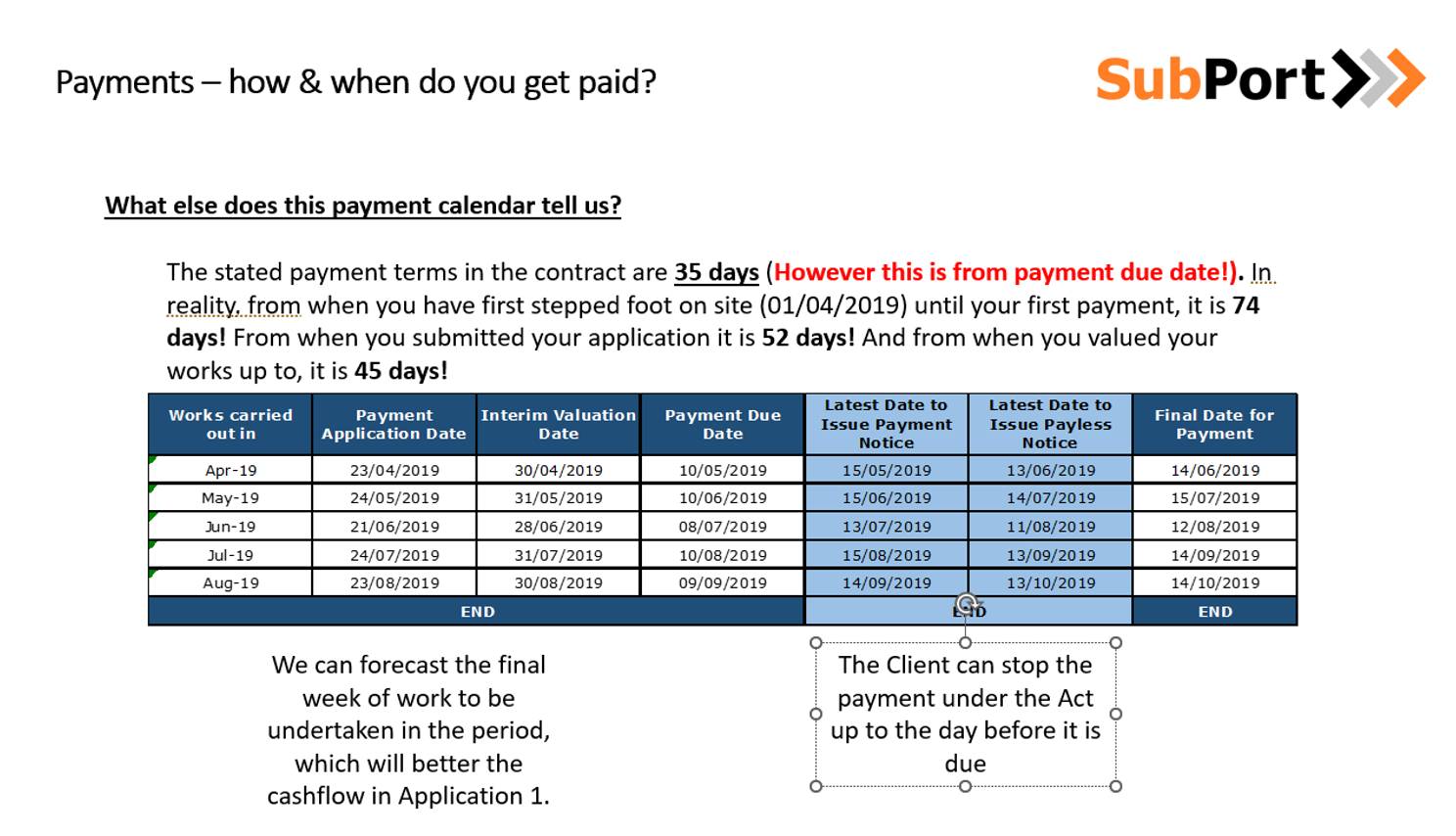Sub-contractor's Payments, Applications and Cashflow
Posted on 23rd November 2023 at 17:47
As a subcontractor, it is crucial to understand the proposed payment process within your Sub-contract. This can significantly impact your cash flow, profitability, and overall success of your business.
In this brief summary, we will explore the importance of the payment process and the implications for you, the subcontractor, along with some basic explanations and helpful tips to help you improve the process.

Different Contracts, Different Terms
Great news for Sub-contractors is that all Construction Contracts are governed by the Construction Act (The Act) and if your Construction Contract doesn’t set out payment provisions in line with the Act, the Scheme for Construction Contracts will apply.
Standard forms of Sub-Contract such as JCT, NEC, FIDIC incorporate the requirements of the Act. We also see a lot of bespoke Sub-contracts which also incorporate The Act. However the ‘devil is always in the detail’. Standard forms are usually significantly amended and each bespoke Sub-contract needs to have the terms read and understood in full to fully appreciate:
• When you submit your application
• What dates your works are valued up to
• The content required within the applications
• Any specific protocols to follow
• When a payment notice is to be issued
• When a pay less notice is to be issued
• When your cash physically is supposed to land within the account
Examples
Below is an example of how different contracts and dates may serve to confuse / delay your cash:


How to Help
The Housing Grants, Construction and Regeneration Act 1996 (Construction Act) was amended by Part 8 of the Local Democracy, Economic Development and Construction Act 2009 (LDEDC Act 2009).
One significant change in the Construction Act is the removal of the requirement for construction contracts to be in writing. It applies to all construction contracts, whether they're fully written, partly written, or completely oral. This change simplifies the process and makes it even more critical to document agreements clearly.• Understand the all of the above and specific dates – if you need some professional advice – ask!
• Negotiate the above where you can – if you don’t ask you don’t get. We regularly negotiate an improved position for our clients. Also remember to ensure that payment for Materials on Site is included within your contract and where possible consider payment for materials off site / upfront.
• Once you’ve taken negotiations as far as you can be sure to:
Submit on Time
Value works up to the correct dates
Present your application in a clear and concise manner
Make sure your application adds up, is cumulative and accurately reflects previous applications and/or certifications
Supplementary information:
Photos
Records
Marked up Drawings
Variation Breakdowns
Instructions
Narrative
Communication prior and after submission with those reviewing
Take into account previous dialogue and comments
The Frustrations of When Receiving a Payless and the Next Steps
Here are the key changes that affect payment processes:
Notice Regime: There's now a more explicit requirement for the paying party to pay the notified sum. Payment and withholding notices have specific rules to ensure clarity in payment disputes.
Conditional Payment Clauses: The Act invalidates clauses that make payments conditional on obligations in other contracts, ensuring you receive payments without unnecessary delays
Payment Notices and Suspension
Despite adopting the above, which should reduce the likelihood of under-certification and disputes, we appreciate receiving a payless or a payment that falls short of expectations can have a huge impact.
The next steps to consider when faced with a payless situation are:
• Communicate: Reach out to the main contractor /client to understand the reasons for the reduced payment and seek clarification on any disputes.
• Resolve Discrepancies: Work collaboratively to resolve any discrepancies or issues that led to the payless.
• Negotiate: If necessary, negotiate and come to a fair agreement on the outstanding amount.
• Protect Your Rights: Be aware of your legal rights and entitlements as a subcontractor including your current terms, the Act and entitlement for suspension, late payment and dispute resolution.
Understanding the payment process and adhering to best practices is vital. Efficient payment management not only ensures a steady cash flow but also promotes positive relationships and your Final Account agreements.
By submitting comprehensive applications on time, presenting and supporting your work accurately, and reviewing previous certificates, you significantly improve your chances of being paid what you are owed and on time.
Subport
SubPort is an award wining quantity surveying consultancy that exclusively works with sub-contractors.
With a cost-effective and flexible service which you can increase or decrease as your requirements, we help sub-contractors on a range of tasks including tendering and estimating, contract support, valuations, cost-management and dispute resolution.
The above information is intended to provide a general overview of the Construction Act and its implications for sub-contractors. Please note that the application of the Act can vary based on the specifics of your individual contracts and legal advice. For guidance tailored to your unique circumstances, we strongly recommend seeking professional legal advice.
Contact our team of commercial consultants today, telephone us on 0333 200 7205 or email at info@subport.co.uk
This content will only be shown when viewing the full post. Click on this text to edit it.
Share this post:







